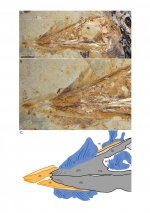Fred Ruhe
Well-known member

Xiaoting Zheng, Jingmai O’Connor, Yan Wang, Xiaoli Wang, Yin Xuwei, XiaomeiZhang, Zhonghe Zhou, 2020
New information on the keratinous beak of Confuciusornis (Aves: Pygostylia) from two new specimens
Frontiers in Earth Sciencw, provisionally accepted, final, formatted version of the article will be published soon.
Abstract: https://www.frontiersin.org/articles/10.3389/feart.2020.00367/abstract
The keratinous beak is inferred to have evolved multiple times in the Archosauria and in Aves. Unfortunately, this feature rarely preserves in the fossil record. Here we examine a collection of 603 specimens belonging to the Confuciusornithiformes, a clade of edentulous basal avians, only two of which preserve visible traces of the rhamphotheca. Preservation is very different between the two specimens, offering no clues as to the taphonomic conditions that are conducive to preservation of this feature. These differences suggest that preservation of the rhamphotheca is not limited to a very narrow set of specific chemical conditions. We suggest the more common preservation of feathers over rhamphotheca is due to the higher melanin content in the former. The well-preserved traces in one specimen described here suggests that the rhamphotheca covering the upper and lower jaws each may consist of a pair of right and left elements, thus differing from the condition in neornithines in which the premaxillary nail and mandibular nail covering the rostral half of the upper and lower jaws respectively each form a single unit.
Enjoy,
Fred
New information on the keratinous beak of Confuciusornis (Aves: Pygostylia) from two new specimens
Frontiers in Earth Sciencw, provisionally accepted, final, formatted version of the article will be published soon.
Abstract: https://www.frontiersin.org/articles/10.3389/feart.2020.00367/abstract
The keratinous beak is inferred to have evolved multiple times in the Archosauria and in Aves. Unfortunately, this feature rarely preserves in the fossil record. Here we examine a collection of 603 specimens belonging to the Confuciusornithiformes, a clade of edentulous basal avians, only two of which preserve visible traces of the rhamphotheca. Preservation is very different between the two specimens, offering no clues as to the taphonomic conditions that are conducive to preservation of this feature. These differences suggest that preservation of the rhamphotheca is not limited to a very narrow set of specific chemical conditions. We suggest the more common preservation of feathers over rhamphotheca is due to the higher melanin content in the former. The well-preserved traces in one specimen described here suggests that the rhamphotheca covering the upper and lower jaws each may consist of a pair of right and left elements, thus differing from the condition in neornithines in which the premaxillary nail and mandibular nail covering the rostral half of the upper and lower jaws respectively each form a single unit.
Enjoy,
Fred




